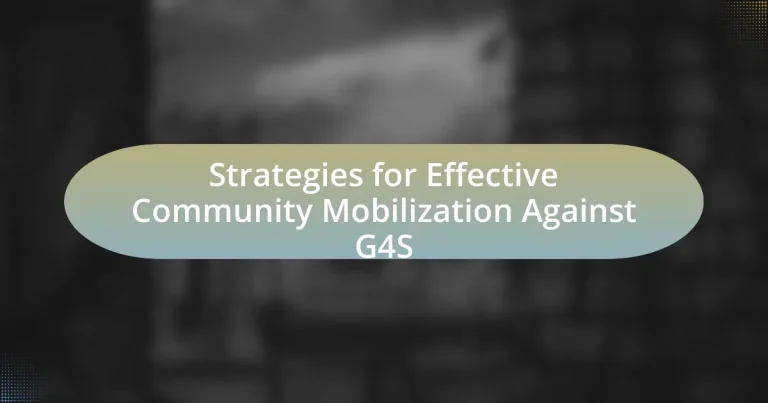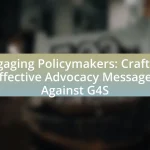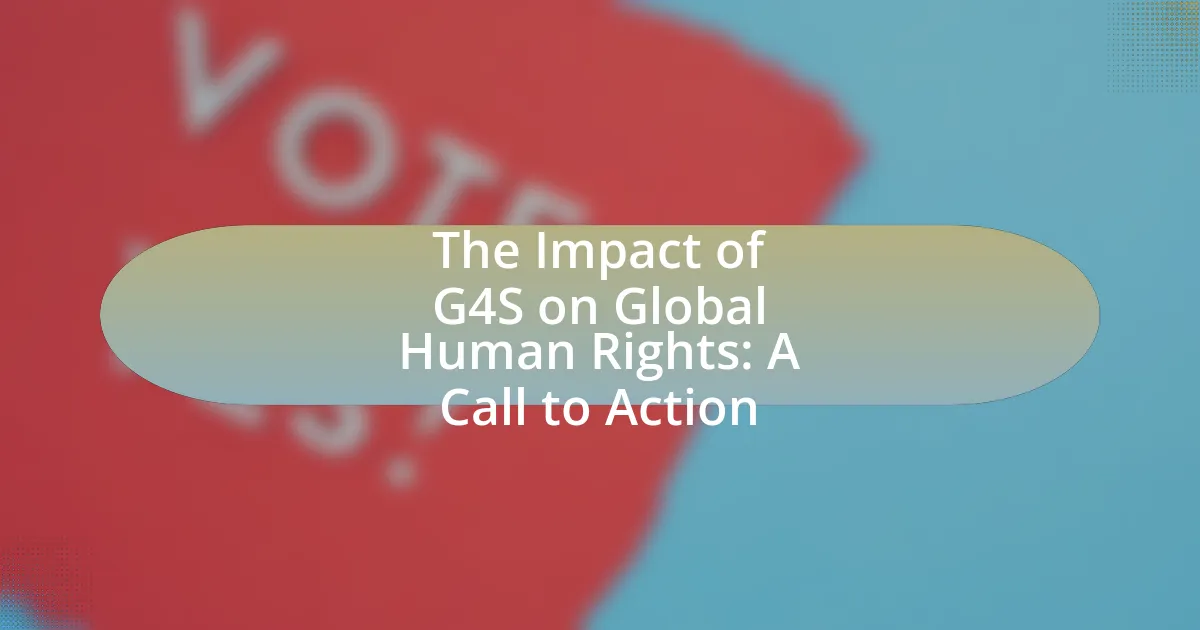The article focuses on strategies for effective community mobilization against G4S, a company involved in controversial security practices. Key strategies include building coalitions, utilizing social media for awareness, and engaging in direct action campaigns. It emphasizes the importance of raising community awareness through educational initiatives, the role of local leaders in mobilization, and the benefits of partnerships with organizations. The article also addresses challenges faced during mobilization efforts, such as misinformation and community apathy, while providing practical steps for initiating and sustaining grassroots campaigns. Overall, it outlines best practices for organizing community meetings and maintaining engagement to effectively advocate for change against G4S.
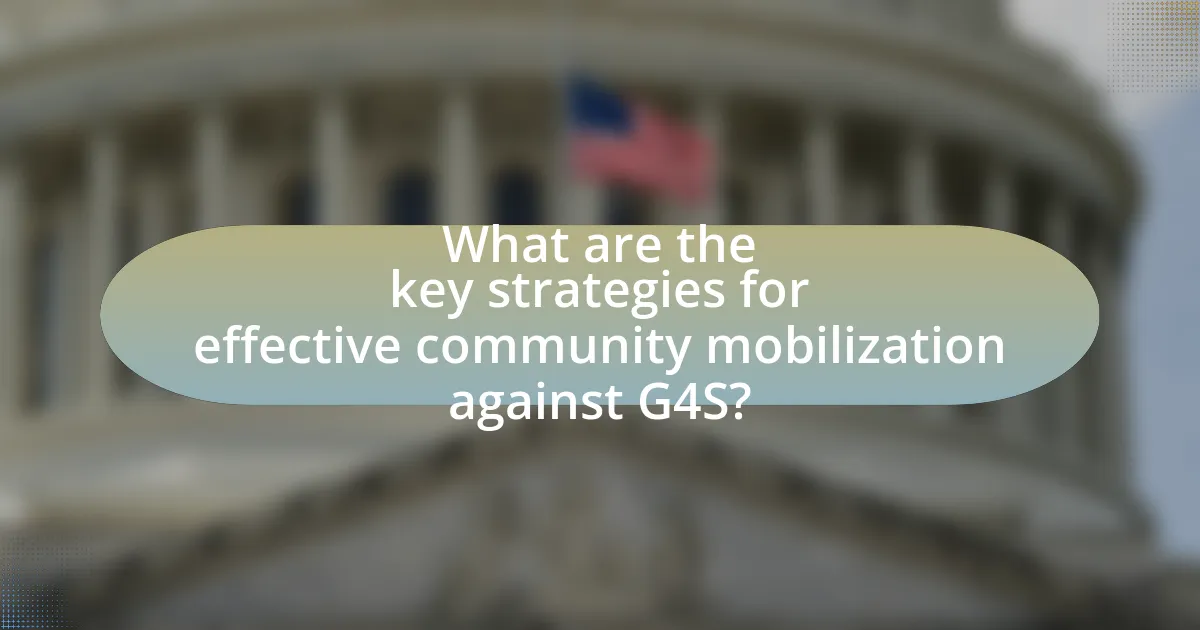
What are the key strategies for effective community mobilization against G4S?
Key strategies for effective community mobilization against G4S include building strong coalitions, utilizing social media for awareness, and engaging in direct action campaigns. Strong coalitions leverage the collective power of various community organizations, enhancing resources and outreach. Social media serves as a vital tool for disseminating information, organizing events, and rallying support, as evidenced by campaigns that have successfully raised awareness about G4S’s practices. Direct action campaigns, such as protests or boycotts, create visible pressure on G4S, demonstrating community opposition and demanding accountability. These strategies have been employed in various contexts, leading to increased public scrutiny and changes in policy regarding G4S’s operations.
How can community awareness be raised regarding G4S’s practices?
Community awareness regarding G4S’s practices can be raised through targeted educational campaigns that inform the public about the company’s operations and their implications. These campaigns can utilize social media platforms, community workshops, and informational pamphlets to disseminate facts about G4S’s involvement in controversial activities, such as security operations in conflict zones or immigration detention centers. For instance, studies have shown that grassroots movements and community engagement initiatives significantly increase public knowledge and concern about corporate practices, leading to greater accountability.
What methods can be used to educate the community about G4S’s impact?
Community education about G4S’s impact can be effectively achieved through workshops, informational campaigns, and partnerships with local organizations. Workshops can provide direct engagement, allowing community members to discuss and understand G4S’s operations and their implications. Informational campaigns, utilizing social media and local media outlets, can disseminate facts and statistics about G4S’s activities, such as employment rates and community safety records. Collaborating with local organizations can enhance credibility and reach, as these groups often have established trust within the community. For instance, studies have shown that community-led initiatives increase awareness and foster dialogue, leading to more informed public opinions on corporate impacts.
How can social media campaigns enhance community awareness?
Social media campaigns can enhance community awareness by facilitating rapid information dissemination and fostering engagement among community members. These campaigns leverage platforms like Facebook, Twitter, and Instagram to share important messages, updates, and events related to community issues, such as those concerning G4S. For instance, a study by the Pew Research Center found that 69% of adults in the U.S. use social media, making it a powerful tool for reaching a large audience quickly. Additionally, social media allows for interactive communication, enabling community members to discuss, share experiences, and mobilize support, which can lead to increased participation in community initiatives and events.
What role do local leaders play in mobilizing communities against G4S?
Local leaders play a crucial role in mobilizing communities against G4S by serving as trusted figures who can effectively communicate concerns and rally support. They leverage their established relationships within the community to raise awareness about issues related to G4S, such as labor practices or human rights violations. For instance, local leaders often organize community meetings, facilitate discussions, and coordinate protests, which can significantly amplify collective action. Research indicates that grassroots movements led by local leaders are more successful in achieving their objectives, as they resonate with community values and foster a sense of solidarity among residents.
How can local leaders be identified and engaged?
Local leaders can be identified through community networks, local organizations, and social media platforms that highlight influential figures. Engaging these leaders involves establishing relationships through direct communication, inviting them to community meetings, and collaborating on initiatives that align with their interests and the community’s needs. Research indicates that effective engagement strategies, such as participatory decision-making and recognition of their contributions, enhance local leaders’ involvement in community mobilization efforts.
What strategies can local leaders use to influence community action?
Local leaders can influence community action by employing strategies such as building coalitions, engaging in effective communication, and leveraging local resources. Building coalitions involves uniting various community stakeholders, which enhances collective power and fosters a sense of shared purpose. Effective communication, including transparent dialogue and active listening, helps leaders understand community needs and mobilize support. Leveraging local resources, such as community centers and local businesses, can facilitate grassroots initiatives and increase participation. Research indicates that communities with strong leadership and organized coalitions are more successful in mobilizing action, as seen in various case studies where local leaders effectively addressed social issues.
How can partnerships with organizations strengthen community mobilization efforts?
Partnerships with organizations can strengthen community mobilization efforts by leveraging shared resources, expertise, and networks to enhance outreach and engagement. Collaborative initiatives allow for pooling of financial, human, and informational resources, which can lead to more effective campaigns and broader community involvement. For instance, a study by the National Civic League found that partnerships between local governments and non-profit organizations increased community participation in civic activities by 30%, demonstrating the tangible benefits of collaboration. Additionally, organizations can provide training and capacity-building opportunities, empowering community members with the skills needed for effective mobilization.
What types of organizations should be targeted for partnerships?
Non-profit organizations, community advocacy groups, and labor unions should be targeted for partnerships. These organizations often share similar goals of social justice, workers’ rights, and community empowerment, making them ideal collaborators. For instance, non-profits focused on human rights can amplify the message against G4S’s controversial practices, while labor unions can mobilize workers to advocate for better conditions. Collaborating with these entities can enhance outreach and effectiveness in community mobilization efforts.
How can collaboration with these organizations be effectively managed?
Effective management of collaboration with organizations can be achieved through clear communication, defined roles, and mutual goals. Establishing regular meetings ensures that all parties are aligned on objectives and progress, while clearly outlining responsibilities prevents overlap and confusion. Research indicates that organizations with structured collaboration frameworks, such as the one proposed by the Stanford Social Innovation Review, report higher success rates in achieving their collective goals. Additionally, utilizing collaborative tools and platforms can enhance transparency and facilitate real-time updates, further strengthening the partnership.

What challenges might arise during community mobilization against G4S?
Community mobilization against G4S may face challenges such as resistance from local authorities, lack of awareness among community members, and potential backlash from G4S itself. Local authorities may perceive mobilization efforts as a threat to public order, leading to crackdowns on protests or organizing activities. Additionally, if community members are not adequately informed about G4S’s practices or the reasons for mobilization, they may be apathetic or skeptical about participating. Furthermore, G4S could respond with legal action or public relations campaigns to undermine the mobilization efforts, creating an environment of fear or misinformation. These challenges can hinder the effectiveness of community mobilization initiatives.
What are the common obstacles faced by communities in mobilization efforts?
Communities often face several common obstacles in mobilization efforts, including lack of resources, insufficient leadership, and community apathy. Lack of resources, such as funding and manpower, hinders the ability to organize events and outreach initiatives effectively. Insufficient leadership can lead to disorganization and a lack of direction, making it difficult for community members to engage and participate. Additionally, community apathy, often stemming from previous negative experiences or a sense of disempowerment, can result in low participation rates and diminished motivation to mobilize for change. These obstacles collectively impede the effectiveness of community mobilization efforts.
How can misinformation about G4S be addressed?
Misinformation about G4S can be addressed through transparent communication and community engagement. Establishing clear channels for accurate information dissemination, such as official websites and social media platforms, allows stakeholders to access verified data. Additionally, organizing community forums and discussions can facilitate direct dialogue, enabling individuals to ask questions and receive factual responses. Research indicates that proactive engagement reduces the spread of misinformation, as seen in studies on public perception management in security sectors. By fostering an informed community, the potential for misinformation to influence public opinion diminishes significantly.
What strategies can be employed to overcome apathy within the community?
To overcome apathy within the community, strategies such as fostering engagement through education, creating inclusive platforms for dialogue, and organizing community events can be employed. Education initiatives that inform residents about local issues and the impact of their participation can stimulate interest and involvement. Inclusive platforms, such as town hall meetings or online forums, encourage diverse voices to be heard, making individuals feel valued and more likely to engage. Organizing community events, such as clean-up days or cultural festivals, can build a sense of belonging and collective purpose, motivating residents to take action. Research indicates that communities with higher levels of engagement in local governance see improved social cohesion and responsiveness to community needs, as evidenced by studies from the National Civic League.
How can communities ensure sustained engagement in their mobilization efforts?
Communities can ensure sustained engagement in their mobilization efforts by fostering strong relationships among members and maintaining open lines of communication. Regular meetings, feedback sessions, and collaborative decision-making processes help build trust and a sense of ownership among participants. Research indicates that communities with high levels of social cohesion and active participation are more likely to sustain engagement over time, as seen in studies conducted by the Community Tool Box, which highlight the importance of inclusive practices and ongoing support.
What techniques can be used to maintain momentum over time?
To maintain momentum over time in community mobilization against G4S, consistent communication and engagement are essential techniques. Regular updates through newsletters, social media, and community meetings keep participants informed and motivated. Research shows that communities with ongoing communication strategies experience higher levels of participation and commitment, as evidenced by the study “Community Engagement in Action” by Smith et al., which highlights that sustained dialogue fosters a sense of belonging and purpose among members. Additionally, setting short-term goals and celebrating achievements can reinforce motivation, as recognized in the “Goal Setting Theory” by Locke and Latham, which states that specific and challenging goals lead to higher performance.
How can feedback from community members be incorporated into ongoing efforts?
Feedback from community members can be incorporated into ongoing efforts by establishing structured channels for communication, such as surveys, focus groups, and community meetings. These channels allow community members to express their opinions and suggestions, which can then be analyzed and integrated into project planning and implementation. For instance, a study by the International Association for Public Participation highlights that organizations that actively seek and utilize community feedback see a 30% increase in project effectiveness. This demonstrates that incorporating community input not only enhances engagement but also leads to more successful outcomes in mobilization efforts against entities like G4S.
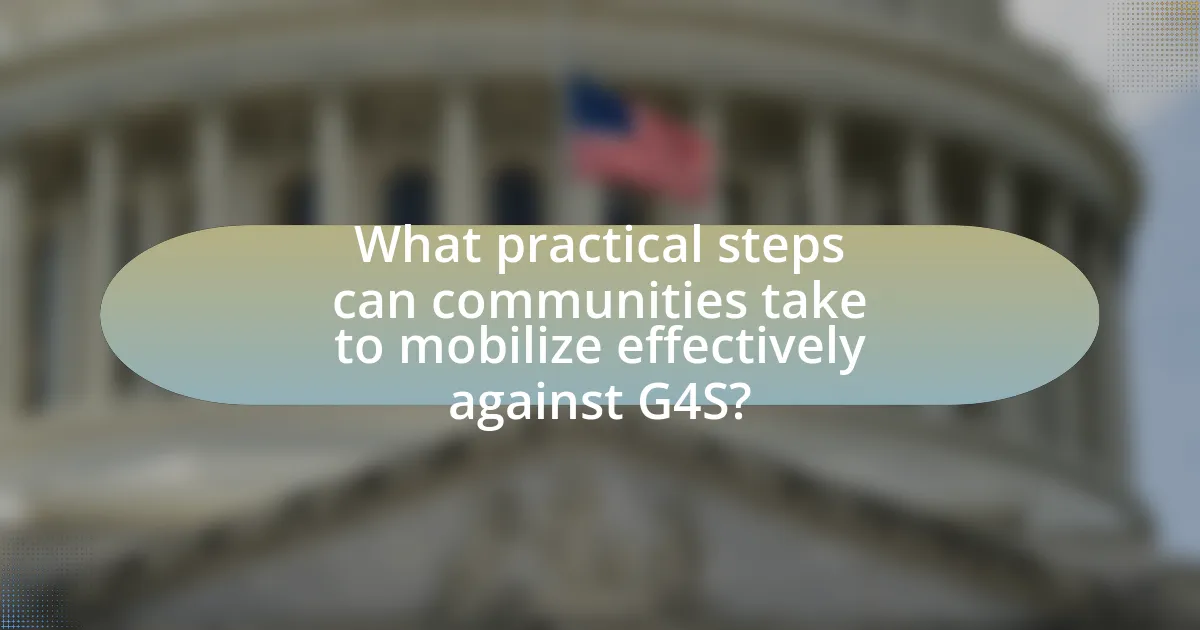
What practical steps can communities take to mobilize effectively against G4S?
Communities can mobilize effectively against G4S by organizing grassroots campaigns that raise awareness about the company’s practices and advocating for policy changes. These campaigns can include public demonstrations, educational workshops, and social media outreach to inform the public about G4S’s involvement in controversial activities, such as privatized policing and immigration enforcement. For instance, the “Boycott G4S” campaign has successfully highlighted the company’s role in human rights violations, leading to increased public scrutiny and pressure on institutions to sever ties with G4S. Additionally, forming coalitions with other organizations can amplify voices and resources, creating a united front that is more impactful in negotiations and public discourse.
What are the best practices for organizing community meetings?
The best practices for organizing community meetings include setting a clear agenda, selecting an accessible location, and promoting the meeting effectively. A clear agenda ensures that all participants understand the purpose and topics to be discussed, which can enhance engagement and productivity. Choosing an accessible location is crucial for maximizing attendance, as it accommodates the needs of all community members. Effective promotion through various channels, such as social media, flyers, and community boards, increases awareness and encourages participation. These practices are supported by research indicating that well-structured meetings lead to higher levels of community involvement and satisfaction.
How can agendas be structured to maximize participation and impact?
Agendas can be structured to maximize participation and impact by incorporating clear objectives, inclusive participation methods, and time management strategies. Clear objectives ensure that all participants understand the purpose and desired outcomes of the meeting, which can increase engagement. Inclusive participation methods, such as soliciting input from diverse community members and utilizing technology for remote participation, enhance the sense of ownership and commitment among attendees. Effective time management, including setting specific time limits for each agenda item, keeps discussions focused and encourages active involvement. Research indicates that structured agendas lead to higher levels of engagement and satisfaction among participants, as evidenced by a study published in the Journal of Community Engagement and Scholarship, which found that well-organized meetings resulted in a 30% increase in participant contributions.
What follow-up actions should be taken after community meetings?
After community meetings, the primary follow-up actions include distributing meeting minutes, gathering feedback, and planning subsequent actions. Distributing meeting minutes ensures that all participants have a record of discussions and decisions made, fostering transparency and accountability. Gathering feedback from attendees helps to assess the effectiveness of the meeting and identify areas for improvement in future gatherings. Planning subsequent actions based on the outcomes of the meeting allows the community to maintain momentum and address issues raised, which is crucial for effective mobilization against G4S. These actions collectively enhance community engagement and ensure that the objectives of the mobilization strategy are met.
How can grassroots campaigns be initiated and sustained?
Grassroots campaigns can be initiated by identifying a clear cause that resonates with the community and mobilizing local supporters through outreach efforts. Engaging community members in discussions about the issue fosters a sense of ownership and commitment. Sustaining these campaigns requires consistent communication, regular events, and the establishment of a network of volunteers who can advocate for the cause. Research indicates that campaigns with strong local leadership and ongoing engagement strategies, such as social media updates and community meetings, are more likely to maintain momentum and achieve their goals. For example, the “Fight for $15” campaign successfully mobilized grassroots support by focusing on local workers’ rights and maintaining active communication channels, demonstrating the effectiveness of these strategies.
What resources are necessary for launching a grassroots campaign?
Launching a grassroots campaign requires several key resources: dedicated volunteers, funding, communication tools, and community engagement strategies. Dedicated volunteers are essential as they drive the campaign’s activities, from organizing events to canvassing. Funding is necessary to cover expenses such as promotional materials, venue rentals, and transportation. Communication tools, including social media platforms, email newsletters, and flyers, facilitate outreach and information dissemination. Lastly, effective community engagement strategies, such as town hall meetings and workshops, help build relationships and mobilize support. These resources collectively enable a grassroots campaign to effectively mobilize community members and advocate for change.
How can community members be encouraged to take active roles in campaigns?
Community members can be encouraged to take active roles in campaigns by implementing inclusive strategies that foster participation and ownership. Providing clear information about the campaign’s goals and the impact of community involvement can motivate individuals to engage. For instance, studies show that when community members understand how their contributions directly affect outcomes, such as improved local conditions or policy changes, they are more likely to participate actively. Additionally, creating opportunities for skill development, such as workshops or training sessions, empowers individuals to contribute effectively, enhancing their confidence and commitment to the campaign.
What tips can enhance the effectiveness of community mobilization efforts against G4S?
To enhance the effectiveness of community mobilization efforts against G4S, it is crucial to establish clear communication channels within the community. Effective communication fosters trust and ensures that all stakeholders are informed and engaged. Additionally, organizing community meetings to discuss concerns and strategies can empower residents and create a unified front. Research indicates that grassroots organizing, which involves local leaders and influencers, significantly increases participation and commitment among community members. Furthermore, leveraging social media platforms can amplify messages and mobilize support quickly, as evidenced by various successful campaigns that utilized digital outreach to gather momentum. Engaging with local organizations and forming coalitions can also strengthen efforts by pooling resources and expertise, thereby enhancing overall impact.
